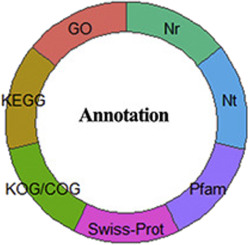当前位置:
X-MOL 学术
›
Comp. Biochem. Physiol. D Genom. Proteom.
›
论文详情
Our official English website, www.x-mol.net, welcomes your
feedback! (Note: you will need to create a separate account there.)
Transcriptome analysis of phototransduction-related genes in tentacles of the sea cucumber Apostichopus japonicus.
Comparative Biochemistry and Physiology D: Genomics & Proteomics ( IF 2.2 ) Pub Date : 2020-02-19 , DOI: 10.1016/j.cbd.2020.100675 Xiaolu Liu 1 , Chenggang Lin 2 , Lina Sun 3 , Shilin Liu 3 , Jingchun Sun 3 , Libin Zhang 3 , Hongsheng Yang 2
Comparative Biochemistry and Physiology D: Genomics & Proteomics ( IF 2.2 ) Pub Date : 2020-02-19 , DOI: 10.1016/j.cbd.2020.100675 Xiaolu Liu 1 , Chenggang Lin 2 , Lina Sun 3 , Shilin Liu 3 , Jingchun Sun 3 , Libin Zhang 3 , Hongsheng Yang 2
Affiliation

|
The sea cucumber Apostichopus japonicus (Selenka)is a typical nocturnal echinoderm, which is believed to be almost completely dependent on light intensity for the regulation of endogenous rhythms. Under conditions of high light intensity, this species shows clear evidence of light avoidance behavior, seeking out shaded areas of reef in which to reside. In this study, we performed RNA-Seq analysis to examine the tentacle transcriptome of A. japonicus specimens that had been subjected to dark and light (5 min and 1 h) conditions. We specifically focused on detecting genes involved in opsin-based light perception, including opsins and members of phototransduction-related pathways. On the basis of comparisons with both vertebrate and invertebrate phototransduction pathways, we determined that components of two of the main metazoan phototransduction pathways were altered in response to illumination. Among the key phototransduction-related genes in tentacles, we identified retinol dehydrogenase, members of the dehydrogenase/reductase family, and myosin III, and also detected a pair of visual pigment-like receptors, peropsin and peropsin-like, the homologous genes of which are believed to have the same function but show opposite expression patterns in response to different light environments. In general, the up-regulation of key genes in sea cucumber exposed to illumination indicated that the tentacles can respond to differences in the light environment at the molecular level.
中文翻译:

刺参触角中光转导相关基因的转录组分析。
海参刺参(Selenka)是典型的夜间棘皮动物,据信它几乎完全依赖光强度来调节内源性节律。在高光强度的条件下,该物种显示出避光行为的明确证据,寻找珊瑚礁的阴影区域。在这项研究中,我们进行了RNA-Seq分析,以检查在黑暗和光亮(5分钟和1小时)条件下日本刺槐的触手转录组。我们特别专注于检测与视蛋白相关的光感知相关的基因,包括视蛋白和光转导相关途径的成员。根据与脊椎动物和无脊椎动物光转导通路的比较,我们确定了两个主要的后生动物光电导途径的成分响应照明而改变。在触角中与光电导相关的关键基因中,我们鉴定了视黄醇脱氢酶,脱氢酶/还原酶家族的成员和肌球蛋白III,还检测到一对视觉色素样受体,peropsin和peropsin-like,它们的同源基因据信具有相同的功能,但是响应于不同的光照环境显示相反的表达模式。通常,暴露在光照下的海参中关键基因的上调表明,触角可以在分子水平上响应光照环境的差异。脱氢酶/还原酶家族成员和肌球蛋白III,并且还检测到一对视觉色素样受体,peropsin和peropsin-like,它们的同源基因被认为具有相同的功能,但响应于不同的光照环境。通常,暴露在光照下的海参中关键基因的上调表明,触角可以在分子水平上响应光照环境的差异。脱氢酶/还原酶家族成员和肌球蛋白III,并且还检测到一对视觉色素样受体,peropsin和peropsin-like,它们的同源基因被认为具有相同的功能,但响应于不同的光照环境。通常,暴露在光照下的海参中关键基因的上调表明,触角可以在分子水平上响应光照环境的差异。
更新日期:2020-02-20
中文翻译:

刺参触角中光转导相关基因的转录组分析。
海参刺参(Selenka)是典型的夜间棘皮动物,据信它几乎完全依赖光强度来调节内源性节律。在高光强度的条件下,该物种显示出避光行为的明确证据,寻找珊瑚礁的阴影区域。在这项研究中,我们进行了RNA-Seq分析,以检查在黑暗和光亮(5分钟和1小时)条件下日本刺槐的触手转录组。我们特别专注于检测与视蛋白相关的光感知相关的基因,包括视蛋白和光转导相关途径的成员。根据与脊椎动物和无脊椎动物光转导通路的比较,我们确定了两个主要的后生动物光电导途径的成分响应照明而改变。在触角中与光电导相关的关键基因中,我们鉴定了视黄醇脱氢酶,脱氢酶/还原酶家族的成员和肌球蛋白III,还检测到一对视觉色素样受体,peropsin和peropsin-like,它们的同源基因据信具有相同的功能,但是响应于不同的光照环境显示相反的表达模式。通常,暴露在光照下的海参中关键基因的上调表明,触角可以在分子水平上响应光照环境的差异。脱氢酶/还原酶家族成员和肌球蛋白III,并且还检测到一对视觉色素样受体,peropsin和peropsin-like,它们的同源基因被认为具有相同的功能,但响应于不同的光照环境。通常,暴露在光照下的海参中关键基因的上调表明,触角可以在分子水平上响应光照环境的差异。脱氢酶/还原酶家族成员和肌球蛋白III,并且还检测到一对视觉色素样受体,peropsin和peropsin-like,它们的同源基因被认为具有相同的功能,但响应于不同的光照环境。通常,暴露在光照下的海参中关键基因的上调表明,触角可以在分子水平上响应光照环境的差异。











































 京公网安备 11010802027423号
京公网安备 11010802027423号